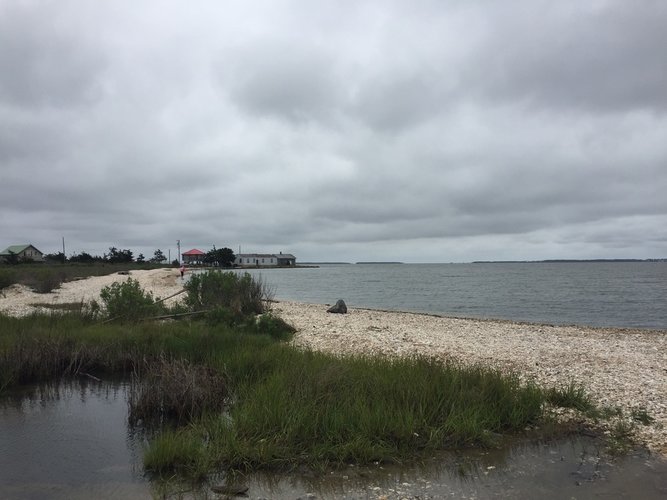|
When driving to the water in Greenbackville, the narrow pavement abruptly turns into shells. The entire bayside shore is made up of shells; there’s no sand or dirt, there’s not even a variety of shells, they all look alike.
For the most part, these are oyster shells which have washed ashore over the last hundred years or so. This particular area of Greenbackville where CBFS has its Living Shoreline site is formerly known as Franklin City. This village was actually a central location for the oyster industry on the East Coast. As of 1920, Greenbackville had 15 oyster shucking houses up and running. You can still see the skeleton of one out on the bay, standing today as a small, dilapidated platform. It was this location that the Chincoteague watermen would ferry their catch over to Franklin City to be processed at the shucking houses. The oyster shells were discarded into the bay and have been gradually washing up on shore, creating this berm-like feature on the shoreline. After canning the oysters, they were sent north to Philidelphia, Baltimore, and New York City for distribution. The “Chincoteague Oyster” is now a delicacy known across the country. Today, the oyster shell beach serves as an environmental obstacle because it prevents the salt marsh from getting the salt water inundation it needs to thrive. The oyster shells block salt water from entering the salt marsh, causing some of our native species to be outcompeted by invasive plants that thrive in waters with lower salinities. The marsh helps protect people who live along the Greenbackville coast because it acts as a flood barrier and lessens the impact of high tides and storms. In addition to being a sort of buffer zone, the marsh also acts as a filter to the bay by collecting pollution and run off from the roads. Through CBFS’s Living Shoreline project we’re trying to restore the marsh to its natural state. Be sure to join us during our upcoming Community Action Days this summer to learn more about the history of Greenbackville and to participate in these restoration efforts! To get on our volunteer mailing list contact Cortney Weatherby at [email protected].
0 Comments
Leave a Reply. |
About
Everything you need to know about CBFS's educational programs, visiting Chincoteague Island, and more! Categories
All
Archives
January 2019
|
CHINCOTEAGUE BAY FIELD STATION | 34001 Mill Dam Road | Wallops Island, VA 23337 | (757) 824-5636 | [email protected]

 RSS Feed
RSS Feed

